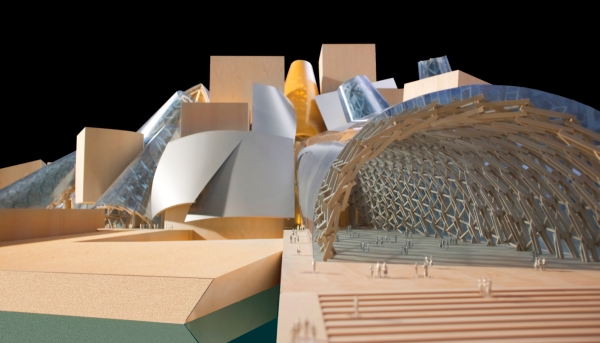Frank Gehry
Centre Pompidou, 8 October 2014 – 26 January 2015

Guggenheim Abu Dhabi makettje, 2006 ┬® Gehry Partners, LLP
The name of Frank Gehry in itself embodies the image of contemporary architecture. Globally recognised for projects that have now made him an icon, his work has revolutionised the aesthetics of architecture, and its social and cultural role within the city. Gehry began to work on his approach in Los Angeles. In the Sixties, he mixed with the Californian art scene and became close to several artists, including Ed Ruscha, Richard Serra, Claes Oldenburg, Larry Bell and Ron Davis. His encounter with the works of Robert Rauschenberg and Jasper Johns opened the way to a reconfiguration of his architectural style, and notably began to introduce the use of poor materials such as cardboard, sheet metal and industrial wire netting. The extension of his own house in Santa Monica was a real manifesto for this new approach. From then on, all Gehry’s projects questioned his own means of expression. This position as a bridge between art and architecture led him to write the most recent history of Los Angeles ŌĆō now a legendary work. At a time when post-modernism was all-conquering, Gehry, on the contrary, avoided it. He talked about this in a celebrated dialogue with the film director Sydney Pollack, who made a biographical film on him in 2005. Gehry’s work ŌĆō both his architecture and the urban vision it conveys ŌĆō is informed by two preoccupations: how to humanise architecture, and how to find a second wind after the first industrial crisis. For Gehry, who is both an architect and a great urban planner, shows us the city through his buildings. The Guggenheim Museum in Bilbao, one of the most speaking examples, was built as an emblem of architecture’s ability to reenergise the economic fabric of the territory. The Centre Pompidou retrospective provides an overall interpretation of his work for the first time in Europe through more than 60 models and nearly 220 original drawings. In a chronological circuit divided into themes, it retraces the lines of force in the career of one of the key figures in contemporary architecture in the second half of the 20th century. Centre Pompidou, 8 October 2014 – 26 January 2015

Guggenheim Abu Dhabi makettje, 2006 ┬® Gehry Partners, LLP
The name of Frank Gehry in itself embodies the image of contemporary architecture. Globally recognised for projects that have now made him an icon, his work has revolutionised the aesthetics of architecture, and its social and cultural role within the city. Gehry began to work on his approach in Los Angeles. In the Sixties, he mixed with the Californian art scene and became close to several artists, including Ed Ruscha, Richard Serra, Claes Oldenburg, Larry Bell and Ron Davis. His encounter with the works of Robert Rauschenberg and Jasper Johns opened the way to a reconfiguration of his architectural style, and notably began to introduce the use of poor materials such as cardboard, sheet metal and industrial wire netting. The extension of his own house in Santa Monica was a real manifesto for this new approach. From then on, all Gehry’s projects questioned his own means of expression. This position as a bridge between art and architecture led him to write the most recent history of Los Angeles ŌĆō now a legendary work. At a time when post-modernism was all-conquering, Gehry, on the contrary, avoided it. He talked about this in a celebrated dialogue with the film director Sydney Pollack, who made a biographical film on him in 2005. Gehry’s work ŌĆō both his architecture and the urban vision it conveys ŌĆō is informed by two preoccupations: how to humanise architecture, and how to find a second wind after the first industrial crisis. For Gehry, who is both an architect and a great urban planner, shows us the city through his buildings. The Guggenheim Museum in Bilbao, one of the most speaking examples, was built as an emblem of architecture’s ability to reenergise the economic fabric of the territory. The Centre Pompidou retrospective provides an overall interpretation of his work for the first time in Europe through more than 60 models and nearly 220 original drawings. In a chronological circuit divided into themes, it retraces the lines of force in the career of one of the key figures in contemporary architecture in the second half of the 20th century.
